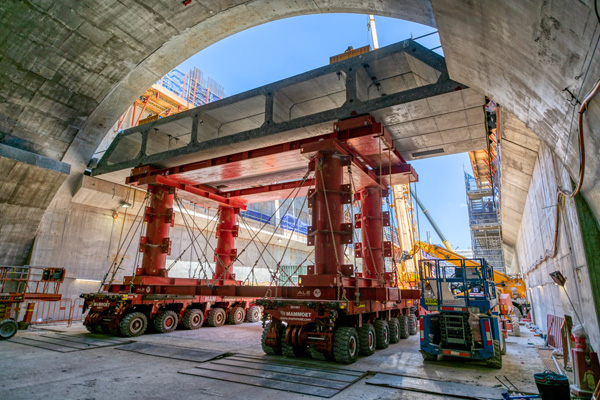The Cross River Rail project aimed to alleviate congestion in Brisbane’s metro transport system and improve transportation for the growing population. However, the project faced numerous obstacles due to limited space – the site is incredibly confined and congested, the construction sequencing was complex with the need for precision, efficiency, and safety.
Kenny Constructions, the civil engineering contractor, needed to install 59 concrete trusses, weighing up to 70 tonnes each, deep within the underground station cavern. Overcoming challenges such as restricted headroom and a few millimetres of clearance on either side of the trusses was critical, all while completing the process in the shortest possible time and with minimum disruptions for the wider site.

The use of cranes was not feasible, so Mammoet embraced the challenge by devising an ingenious solution. They proposed a custom packing structure positioned on Self-propelled Modular Trailers (SPMTs), which enabled the transportation and installation of up to four trusses simultaneously, significantly accelerating the overall process.
To validate the solution, the team assembled the packing structure and transport configuration in their nearby yard, conducting a series of dry runs. After thorough preparation and on-site rehearsals, the actual operations commenced.
The customer’s tower crane lowered the trusses onto the packing structure, before they were delicately maneuvered through the confined cavern. The hydraulic suspension and electrical multi-steering system of the SPMTs enabled them to carefully position the trusses on their designated positions.
The operation’s most challenging aspect was the limited clearance. Each of the trusses had a span of 17.6m, leaving just 100mm on either side – a little more than the width of a credit card. Yet the first set of trusses, with a combined weight of 193t, had to travel to the very far end of the station cavern, a distance of 150m – the length of three Olympic sized swimming pools.
In the first phase, 55 trusses, weighing 48.3t each, were installed, followed by four extra-large trusses weighing 70t each in the second phase. Yet, as part of operation pre-planning Mammoet ensured that the same configuration could be used for both phases, bringing further time savings. With each journey transporting and installing up to four trusses, totalling approximately 15 iterations.
Thanks to the meticulous planning, specialized equipment, and expert execution, the entire operation proceeded smoothly. Fergus McHugh, Project Manager at Kenny Constructions, praised Mammoet, stating,
“This was a challenging scope of works, yet everything went according to plan. Working with the Mammoet team was a pleasure. We made the right choice.”

The safe and efficient completion of the scope has made a significant contribution to the AUS$5.4 billion Cross River Rail project. The addition of four new underground stations, more than 10km of new rail line and 5.9km of twin tunnels beneath the Brisbane River and the central business district will reduce peak hour travel times by 24% and accommodate 9,000 additional passengers daily.
By employing its expertise and innovative solutions, Mammoet helped unlock a bottleneck in the city’s transport network and contributed to the region’s economic growth. This infrastructure development supports the projected 40% population growth in South East Queensland, providing a substantial boost to the regional economy.





